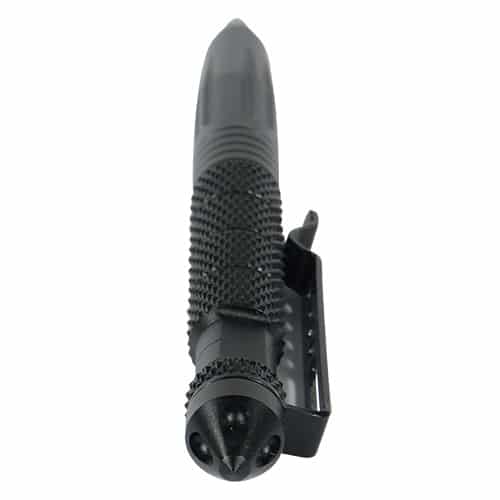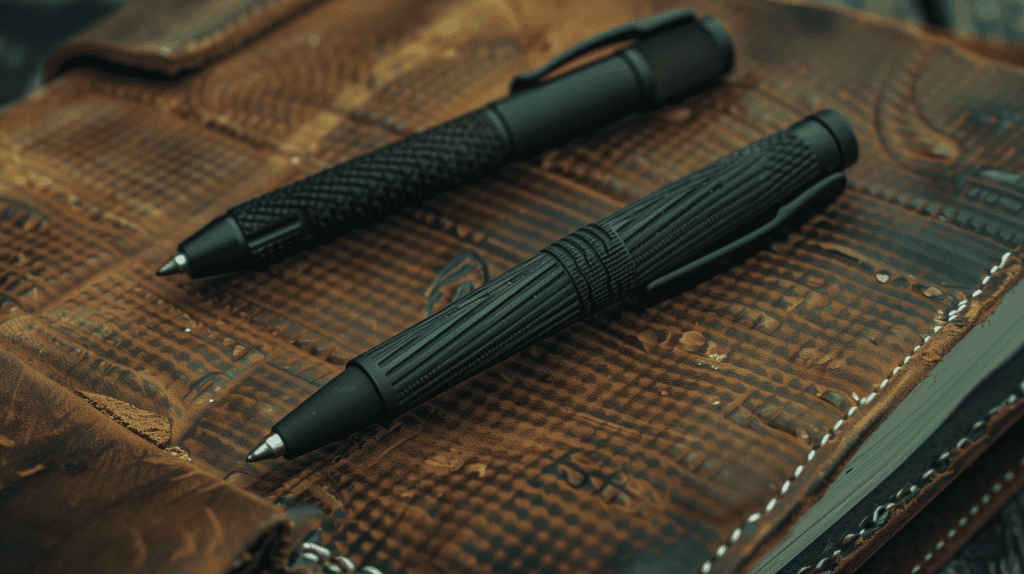What are the pros and cons of carrying tactical pens? Well, tactical pens are a sturdy and discreet self-defense tool that easily integrates into your everyday carry. They maintain writing capabilities in all weather conditions and offer a non-lethal option for protection. However, their legality can be murky, as some places consider them weapons. You’ll need to check local laws to ascertain compliance. Durable yet lightweight, these pens require minimal training for effective use. For a deeper understanding of their versatility and restrictions, explore further into this unique tool’s features.
Key Takeaways
- Tactical pens offer dual functionality as writing instruments and self-defense tools.
- They are durable, withstanding extreme conditions and providing emergency utility like glass breaking.
- Legally less conspicuous than other weapons, though subject to regional restrictions.
- Minimal training required, but effectiveness in self-defense is limited compared to specialized tools.
- Regular maintenance needed for optimal writing performance and self-defense readiness.
Understanding Tactical Pens: Features and Functions
While you might think of them as just another writing tool, tactical pens are designed to go beyond ordinary pen functions.
These EDC pens aren’t just for jotting down notes; they’re constructed from robust materials like aircraft-grade aluminum or titanium, ensuring they last through tough conditions.
Besides their superior writing performance, many tactical pens feature a glass breaker tip, an essential tool in emergency situations where you might need to shatter a window swiftly.
These pens are discreet, resembling ordinary pens, which makes them easy to carry without drawing attention.
Whether for self-defense or emergency uses, a tactical pen is a versatile addition to your everyday carry gear.
The Advantages of Tactical Pens for Everyday Use
Tactical pens bring more than just ink to your everyday carry; they offer a durable and reliable tool that thrives in both daily writing tasks and emergency scenarios.
Crafted from materials like aerospace-grade aluminum or titanium, these pens aren’t just tough; they’re built to last. Whether you’re signing documents or need a sturdy option in a pinch, your tactical pen is up to the task.
Discover the unmatched durability of tactical pens, designed for both everyday use and emergency situations.
Its discreet design means you’ll carry it everywhere without a second thought, seamlessly integrating into your EDC.
Plus, with self-defense capabilities like a pointed tip, you’re quietly prepared for unexpected situations.
Opt for a tactical pen and enhance your preparedness with a tool that’s as practical as it’s tough.
How Tactical Pens Compare to Other Self-Defense Tools
If you’re considering a self-defense tool that blends seamlessly into your daily life, a tactical pen might just be the ticket.
When you stack it up against other self-defense tools, here’s how it measures:
- Discretion: Tactical pens are less conspicuous than knives, comfortably fitting into your everyday carry without signaling “weapon.”
- Ease of Use: You’ll need minimal training to use a tactical pen effectively, unlike more complex tools.
- Dual Functionality: Not just for defense, it’s also your trusty pen for everyday tasks.
- Non-lethal: A tactical pen provides a non-lethal way to defend yourself, aligning with both legal and moral considerations.
- Legal Friendliness: The legal landscape generally views tactical pens more favorably than more overt weapons like knives.
Legal Considerations and Restrictions of Tactical Pens
Before you slip a tactical pen into your pocket or purse, it’s vital to understand the legal landscape surrounding these tools. While generally legal, tactical pens can be subject to varied local laws, especially in urban areas, schools, and airports.
You’ll find that some states categorize them as weapons due to their self-defense capabilities, aligning them with the restrictions for knives or firearms. Despite their design often mimicking ordinary pens, which helps legally, it’s important to know your region’s specific rules.
Additionally, while they might be allowed where other self-defense instruments aren’t, always verify how and when you can legally use one in a self-defense scenario, as this can greatly differ depending on the situation.
Watch an informative video about effectively using a tactical pen.
The Design and Ergonomics of Top Tactical Pens
Understanding the legal landscape of tactical pens sets the stage for appreciating their thoughtful design and functionality. These pens are more than just writing tools; they’re part of your everyday carry (EDC) that combines practicality with defense readiness.
Explore how tactical pens merge everyday practicality with defense readiness, transforming simple writing tools into essential EDC gear.
- Durable Materials: Made from aircraft-grade aluminum, titanium, or stainless steel, these pens withstand tough conditions.
- Ergonomic Designs: Textured grips and triangular shapes enhance handling, guaranteeing comfort and control.
- Compact Size: Typically 4.3 to 6.75 inches long, they’re easy to carry yet balanced in your hand.
- Discreet Aesthetics: Designed to look like regular pens, they blend seamlessly into your daily gear.
- Innovative Features: Bolt-action mechanisms and secure grips make deployment swift and reliable in emergencies.
These design elements ascertain your tactical pen is both a reliable tool and a discreet protector.
How to Choose the Right Tactical Pen for Your Needs

When choosing a tactical pen, you’ll want to weigh the material it’s made from, as options like aircraft-grade aluminum offer durability without too much heft.
Guarantee the pen has refillable ink cartridges to keep it functional long term, and don’t overlook self-defense features that align with your personal security needs.
Each detail counts when it comes to selecting a pen that’s both practical for writing and effective in a pinch.
Pictured above is the Black Twist Tactical Pen currently on sale at Nittany Self Defense.
Pen Material Consideration
Choosing the right material for your tactical pen is essential, as it directly influences the pen’s durability, weight, and functionality. Here’s what to take into account:
- Aircraft-Grade Aluminum: Lightweight and durable, perfect for daily carry without dragging you down.
- Titanium: Offers supreme durability with a slightly higher weight, ideal for those who prefer a solid feel.
- Stainless Steel: Heavier, which can be reassuring; guarantees your pen withstands tough conditions.
- Anodized Finish: Enhances corrosion resistance and adds a sleek look to your tactical tool.
- Ergonomic Design: Regardless of the material, make sure it fits comfortably in your hand, making it easier to wield, whether you’re writing or defending yourself.
Ink Refill Options
After settling on the material and design of your tactical pen, you’ll want to confirm that it’s as functional in writing as it’s in self-defense.
Choosing a model with refillable ink cartridges, like the universally compatible Fisher Space Pen refills, guarantees you’re never caught without ink.
Evaluate refill options carefully; the availability of specific ink types—gel, ballpoint, or rollerball—can greatly affect your writing performance.
Opt for a pen that supports standard refills for ease of replacement and consider the ink cartridge’s capacity.
Longer-lasting cartridges not only improve practicality but also reduce waste, making your tactical pen a reliable tool for both writing and emergency situations.
Self-Defense Features
A tactical pen isn’t just a tool for writing; it’s also your portable safeguard in times of need.
When choosing the right tactical pen for self-defense, consider these features:
- Construction Material: Opt for aircraft-grade aluminum or stainless steel for superior durability and impact resistance.
- Self-Defense Capabilities: ascertain it includes a glass breaker tip or a sharp striking end.
- Activation Mechanism: Select a pen with an easy activation method like a click top, twist, or bolt action, especially under stress.
- Size and Weight: Find a balance between comfortable writing and effective striking. It shouldn’t be too heavy or cumbersome.
- Reliability: Check user reviews and expert recommendations to ascertain both effective self-defense functionality and smooth writing performance.
Practical Tests and Performance Evaluations of Tactical Pens
When you’re considering a tactical pen, you might wonder about its toughness and how well it writes in tough conditions.
Pen durability trials have shown that some models can withstand extreme pressure, like being run over by a heavy vehicle, without breaking.
Meanwhile, writing efficiency tests guarantee that these pens don’t just survive hard knocks but also perform well on wet or unusual surfaces, keeping you prepared for any situation.
Pen Durability Trials
Tactical pens aren’t your average writing tool; they’re built to withstand conditions that would destroy ordinary pens.
During durability trials, these pens undergo rigorous testing to showcase their robustness and multifunctional capabilities.
Here’s what you’ll find intriguing:
- Survivability: They can be run over by a 5,000-pound truck and come out unscathed.
- Glass-Breaking Capabilities: Capable of shattering car windows to aid escapes.
- Wet Conditions Performance: Tested to write smoothly on wet notepads.
- Self-Defense Readiness: Striking tests confirm they can be effectively used in personal defense.
- Balanced Features: Evaluated for material strength, weight, and quick deployment.
These trials guarantee your tactical pen isn’t just for writing—it’s a reliable tool in emergencies.
Writing Efficiency Tests
While the ruggedness of tactical pens often steals the spotlight, their performance in writing tests is equally essential for those who rely on them in high-stress environments.
You’ll find that tactical pens, tested on Rite in the Rain notepads, maintain smooth writing even when wet. This is pivotal in tactical situations where moisture is a constant.
The pen cartridges, like the Schneider Gelion, are designed for a steady ink flow, guaranteeing you won’t face frustrating interruptions during critical moments.
Most models prioritize grip comfort and ergonomics, enhancing usability during extended writes.
However, some pens do vary in fluidity and smudge resistance, so you’ll want to choose carefully to confirm you’re equipped with a reliable, high-performing writing instrument.
Maintenance and Care for Tactical Pens
To keep your tactical pen in top condition, it’s essential to regularly check and replace the ink cartridge as needed.
Maintenance doesn’t stop there, though. Here’s a quick guide to guarantee your tactical pen is always ready:
- Clean the exterior: Wipe down with a soft cloth to keep the striking tips clear and functional.
- Check the glass-breaking tip: Inspect for damage or dulling to maintain its effectiveness.
- Lubricate the mechanism: Prevent jamming and guarantee smooth operation with appropriate lubricants.
- Store properly: Keep it in a cool, dry place to protect materials and ink quality.
- Inspect regularly: Stay ahead of any potential issues by keeping an eye on all components.
Tactical Pen Training Techniques and Effectiveness
If you’re considering using a tactical pen for self-defense, understanding proper training techniques is essential for its effectiveness.
Tactical pen training focuses on basic striking methods and grip control, ideal for those with little or no martial arts background. You’ll engage in drills that mimic surprise attacks, prepping you to swiftly use the pen as a self-defense tool.
Furthermore, these exercises enhance your fine motor skills and situational awareness, important for accurately deploying the pen while under pressure.
Learning the legal aspects of self-defense and the importance of minimal force is also integral. Many programs emphasize awareness, advising when to opt for the pen and when to attempt verbal de-escalation, ensuring you’re prepared yet responsible.
Future Trends and Innovations in Tactical Pen Design
As you explore the evolving world of tactical pens, you’ll notice that future models are likely to feature integrated tech enhancements like built-in LED lights or emergency communication tools, which can be essential in a pinch.
Manufacturers are also shifting towards using sustainable materials, ensuring that your tactical pen isn’t only effective but also environmentally friendly.
These innovations make the pen not only a tool for writing or self-defense but also a gadget that aligns with modern technological and ecological standards.
Integrated Tech Enhancements
While the core function of tactical pens remains unchanged, the horizon of their capabilities is expanding considerably with integrated tech enhancements.
Future designs aren’t just about writing or self-defense; they’re becoming an essential part of your high-tech toolkit.
- Bluetooth Connectivity: Sync your pen with your phone for digital note-taking and swift emergency communications.
- Multi-tools: Integrated tools like screwdrivers or bottle openers make your pen a versatile companion.
- Biometric Locks: Guarantee that only you can use your pen’s defensive features with advanced biometric security.
- LED Lights: Illuminate your path or focus on detailed tasks in low light conditions.
- Smart Technology: Receive alerts and track your pen if it’s misplaced, all via your smartphone.
These enhancements make tactical pens more practical and secure than ever.
Sustainable Materials Use
Building on the innovative features of modern tactical pens, the next wave of design is set to address environmental concerns head-on.
You’ll see more tactical pens crafted from sustainable materials like recycled aluminum and eco-friendly plastics. Innovators are even exploring biodegradable composites that allow these pens to decompose naturally, leaving no harmful residues.
Furthermore, the inclusion of plant-based inks in refillable cartridges exemplifies the shift towards more sustainable practices. This isn’t just about reducing environmental impact; it’s also about enhancing portability with lightweight materials such as advanced polymers, which cut down on resource consumption.
Plus, companies are now ensuring that their materials are ethically sourced, keeping their supply chains transparent to appeal to you, the eco-aware consumer.
Frequently Asked Questions
Should I Carry a Tactical Pen?
You should consider carrying a tactical pen as it’s a versatile self-defense tool, everyday carry item, and writing instrument, useful in emergency situations without the conspicuousness of traditional weapons.
Will TSA Take My Tactical Pen?
TSA might confiscate your tactical pen based on its features. For a smoother airport experience, check the latest TSA guidelines on tactical pen regulations and carry-on restrictions, especially if you’re using it for self-defense.
What Are the Pros and Cons of Stylus Pen?
You’ll find stylus pens a double-edged sword; their precision and smudge-free interaction dazzle, yet they can be costly. Balancing benefits like ergonomic design against drawbacks like price, they outshine fingers but weigh on wallets.
What Pen Do Navy Seals Use?
Navy SEALs often use the SureFire Pen IV, which excels in writing performance and doubles as self-defense gear. Its tactical pen features are designed for durability and discreet, effective use in any situation.
Conclusion
As you’ve explored, tactical pens aren’t just writing tools; they’re a blend of function and defense. Curiously, they coincide with everyday needs while offering peace of mind. Opt for one if you value utility plus a layer of security. Remember, though, to check local laws to stay compliant. Proper training enhances their effectiveness, so consider a class. Keep it maintained, and who knows? Your tactical pen might just be your unexpected hero in a tight spot.



